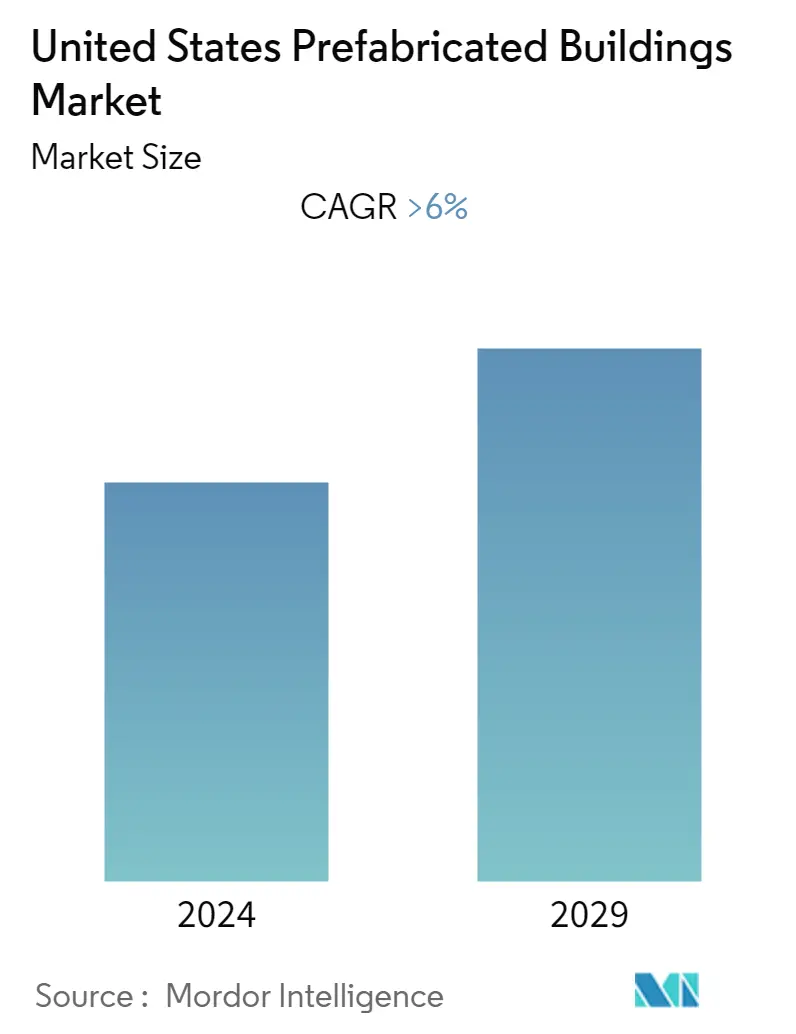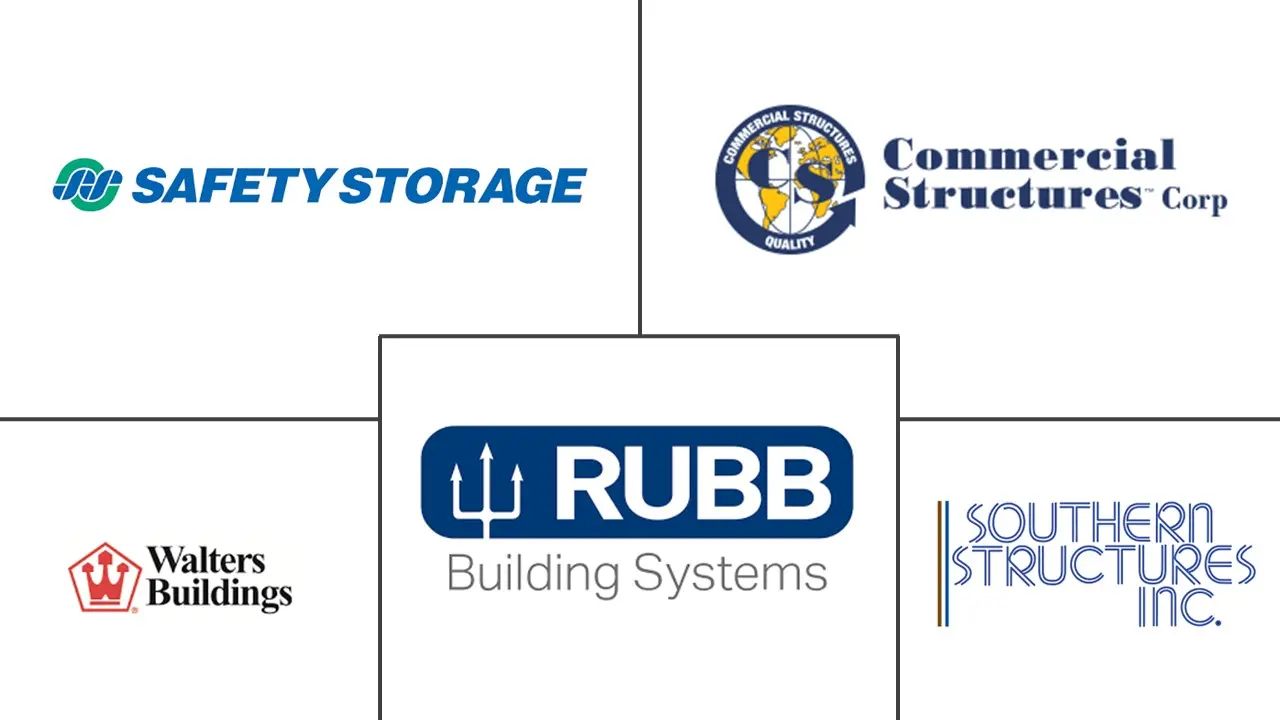Market Size of United States Prefabricated Buildings Industry

| Study Period | 2020 - 2029 |
| Base Year For Estimation | 2023 |
| Forecast Data Period | 2024 - 2029 |
| Historical Data Period | 2020 - 2022 |
| CAGR | 6.00 % |
| Market Concentration | Low |
Major Players
*Disclaimer: Major Players sorted in no particular order |
US Prefabricated Building Market Analysis
The size of the US Prefabricated Buildings Market is USD 21.2 billion, and it is anticipated to register a CAGR of over 6% during the forecast period. Prefabrication in construction is becoming more popular due to the construction sector's explosive growth in automation.
- Due to a lack of qualified labor and the need to raise building quality, the construction business, mainly residential construction, is moving toward prefabricated construction approaches. The most significant issues with housing today include lengthy waiting lines, exorbitant rents, thousands of homeless people, millions living in unsafe or inappropriate accommodations, and a generation of young people priced out of the market.
- Home prices countrywide are increasing at double the income rate and triple the inflation rate as supply cannot keep up with demand. The affordable housing dilemma is still a big issue in the United States, and it only worsens yearly. A sector that generates more than 640 billion USD in GDP employs about 7 million people and yearly builds USD 1.3 trillion worth of construction, as reported in 2021, cannot afford the cost of doing anything to address the issue.
- The total market share of off-site built single-family homes (modular and panelized), according to research by the National Association of Home Builders (NAHB) and the Census Bureau, was 2% of single-family completions in 2021. Despite the significant demand for non-site-built construction, this percentage has been consistently dropping since the early 2000s. Out of the 970,000 completed single-family dwellings, 24,000 modular (10,000) and panelized/pre-cut (14,000) construction-method single-family units were created in 2021. Although the market share is tiny, there is room for growth.
- Even though there is a labor shortage and another crisis in the country, the demand for modular or prefabricated buildings is high due to ease of construction, cost optimization, and installation. The upward trend in the modular construction and the real estate sector is expected to drive the market over the forecast period.
US Prefabricated Building Industry Segmentation
A modular building is a prefabricated structure made up of repeatedly placed components known as modules. When a structure is modular, pieces are built elsewhere and transported to the desired location. The prefabricated parts are installed onsite.
A comprehensive background analysis of the US Prefabricated Buildings Market, covering the current market trends, restraints, technological updates, and detailed information on various segments and the competitive landscape of the industry. The impact of COVID-19 has also been incorporated and considered during the study.
The US prefabricated buildings market is segmented by type (concrete, glass, metal, timber, and other material types) and application (residential, commercial, and other applications (infrastructure and industrial)). The report offers the market size in value terms in USD for all the abovementioned segments.
| By Type | |
| Concrete | |
| Glass | |
| Metal | |
| Timber | |
| Other Material Types |
| By Application | |
| Residential | |
| Commercial | |
| Other Applications (Infrastructure and Industrial) |
United States Prefabricated Buildings Market Size Summary
The US prefabricated buildings market is experiencing a notable expansion, driven by the increasing adoption of prefabrication techniques in the construction industry. This shift is largely attributed to the sector's need to address challenges such as labor shortages and the demand for higher building quality. The construction industry, particularly residential construction, is increasingly turning to prefabricated methods to overcome issues like long wait times for housing, rising rents, and the growing affordability crisis. Despite the small market share of off-site built single-family homes, there is significant potential for growth in this segment. The demand for modular and prefabricated buildings is bolstered by their cost-effectiveness and ease of construction, making them an attractive option in the current economic climate.
The market landscape is characterized by a high degree of fragmentation, with numerous international players competing primarily on price. Technological advancements, such as cloud-based software solutions and improved prefabricated materials, are enhancing operational efficiencies and driving market growth. The Southern, Florida, and Texas regions are particularly prominent in the adoption of prefabricated homes, reflecting a broader trend towards cost-effective housing solutions. Despite fluctuations in the housing market and rising interest rates, the demand for manufactured housing remains strong, offering a viable solution to the ongoing affordability challenges faced by many American households.
United States Prefabricated Buildings Market Size - Table of Contents
-
1. MARKET INSIGHTS DYNAMICS
-
1.1 Current Market Scenario
-
1.2 Market Dynamics
-
1.2.1 Drivers
-
1.2.1.1 Expansion of Mass Township Projects
-
1.2.1.2 Growing adoption of modular construction in the hospitality sector
-
-
1.2.2 Restraints
-
1.2.2.1 Logitsics and transport issue
-
1.2.2.2 Volatility in raw material prices
-
-
1.2.3 Opportunities
-
1.2.3.1 Escalating demand for house-on-wheels or mobile houses
-
-
-
1.3 Industry Attractiveness - Porter's Five Force Analysis
-
1.3.1 Threat of New Entrants
-
1.3.2 Bargaining Power of Buyers/Consumers
-
1.3.3 Bargaining Power of Suppliers
-
1.3.4 Threat of Substitute Products
-
1.3.5 Intensity of Competitive Rivalry
-
-
1.4 Value Chain / Supply Chain Analysis
-
1.5 Technological Advancements in Prefabricated Buildings Market
-
1.6 Pricing Analysis and Revenue Analysis of Prefabricated Buildings Market
-
1.7 Insights on Types and Features of Prefabricated Buildings
-
1.8 Impact of COVID-19 on the Market
-
-
2. MARKET SEGMENTATION
-
2.1 By Type
-
2.1.1 Concrete
-
2.1.2 Glass
-
2.1.3 Metal
-
2.1.4 Timber
-
2.1.5 Other Material Types
-
-
2.2 By Application
-
2.2.1 Residential
-
2.2.2 Commercial
-
2.2.3 Other Applications (Infrastructure and Industrial)
-
-
United States Prefabricated Buildings Market Size FAQs
What is the current US Prefabricated Buildings Market size?
The US Prefabricated Buildings Market is projected to register a CAGR of greater than 6% during the forecast period (2024-2029)
Who are the key players in US Prefabricated Buildings Market?
Southern Structures, Inc., Walters Buildings, Rubb Building Systems, Safety Storage, Inc. and Commercial Structures Corp. are the major companies operating in the US Prefabricated Buildings Market.

